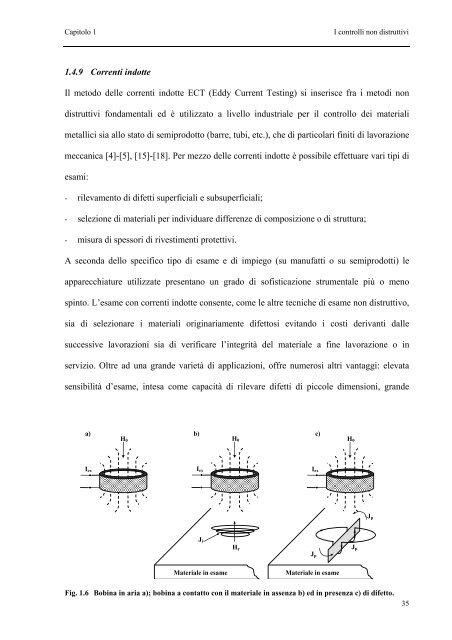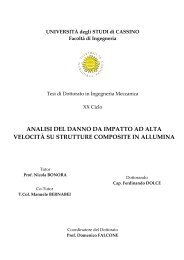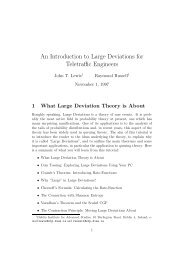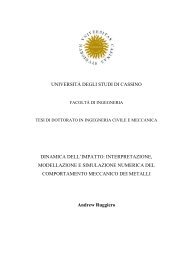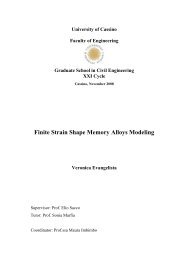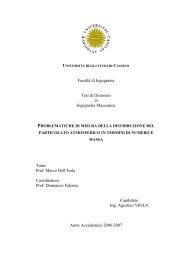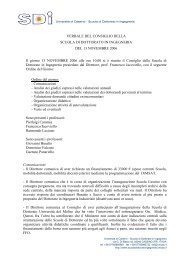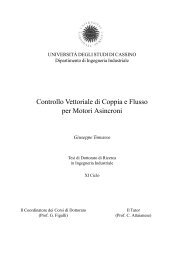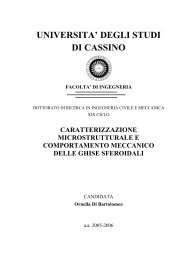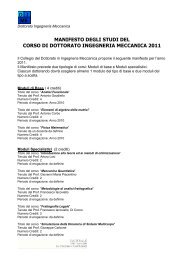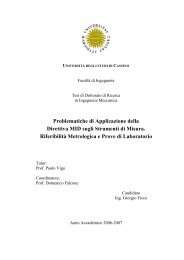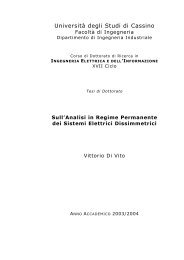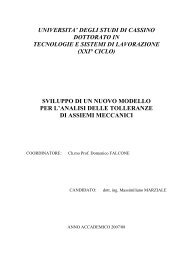Metodi e strumenti di misura per l'esecuzione di test non distruttivi ...
Metodi e strumenti di misura per l'esecuzione di test non distruttivi ...
Metodi e strumenti di misura per l'esecuzione di test non distruttivi ...
You also want an ePaper? Increase the reach of your titles
YUMPU automatically turns print PDFs into web optimized ePapers that Google loves.
Capitolo 1 I controlli <strong>non</strong> <strong>di</strong>struttivi<br />
1.4.9 Correnti indotte<br />
Il metodo delle correnti indotte ECT (Eddy Current Testing) si inserisce fra i meto<strong>di</strong> <strong>non</strong><br />
<strong>di</strong>struttivi fondamentali ed è utilizzato a livello industriale <strong>per</strong> il controllo dei materiali<br />
metallici sia allo stato <strong>di</strong> semiprodotto (barre, tubi, etc.), che <strong>di</strong> particolari finiti <strong>di</strong> lavorazione<br />
meccanica [4]-[5], [15]-[18]. Per mezzo delle correnti indotte è possibile effettuare vari tipi <strong>di</strong><br />
esami:<br />
- rilevamento <strong>di</strong> <strong>di</strong>fetti su<strong>per</strong>ficiali e subsu<strong>per</strong>ficiali;<br />
- selezione <strong>di</strong> materiali <strong>per</strong> in<strong>di</strong>viduare <strong>di</strong>fferenze <strong>di</strong> composizione o <strong>di</strong> struttura;<br />
- <strong>misura</strong> <strong>di</strong> spessori <strong>di</strong> rivestimenti protettivi.<br />
A seconda dello specifico tipo <strong>di</strong> esame e <strong>di</strong> impiego (su manufatti o su semiprodotti) le<br />
apparecchiature utilizzate presentano un grado <strong>di</strong> sofisticazione strumentale più o meno<br />
spinto. L’esame con correnti indotte consente, come le altre tecniche <strong>di</strong> esame <strong>non</strong> <strong>di</strong>struttivo,<br />
sia <strong>di</strong> selezionare i materiali originariamente <strong>di</strong>fettosi evitando i costi derivanti dalle<br />
successive lavorazioni sia <strong>di</strong> verificare l’integrità del materiale a fine lavorazione o in<br />
servizio. Oltre ad una grande varietà <strong>di</strong> applicazioni, offre numerosi altri vantaggi: elevata<br />
sensibilità d’esame, intesa come capacità <strong>di</strong> rilevare <strong>di</strong>fetti <strong>di</strong> piccole <strong>di</strong>mensioni, grande<br />
a) b) c)<br />
Iex<br />
H0<br />
Iex<br />
Ji<br />
H0<br />
Hr<br />
Materiale in esame Materiale in esame<br />
Fig. 1.6 Bobina in aria a); bobina a contatto con il materiale in assenza b) ed in presenza c) <strong>di</strong> <strong>di</strong>fetto.<br />
Iex<br />
Jp<br />
H0<br />
Jp<br />
Jp<br />
35


